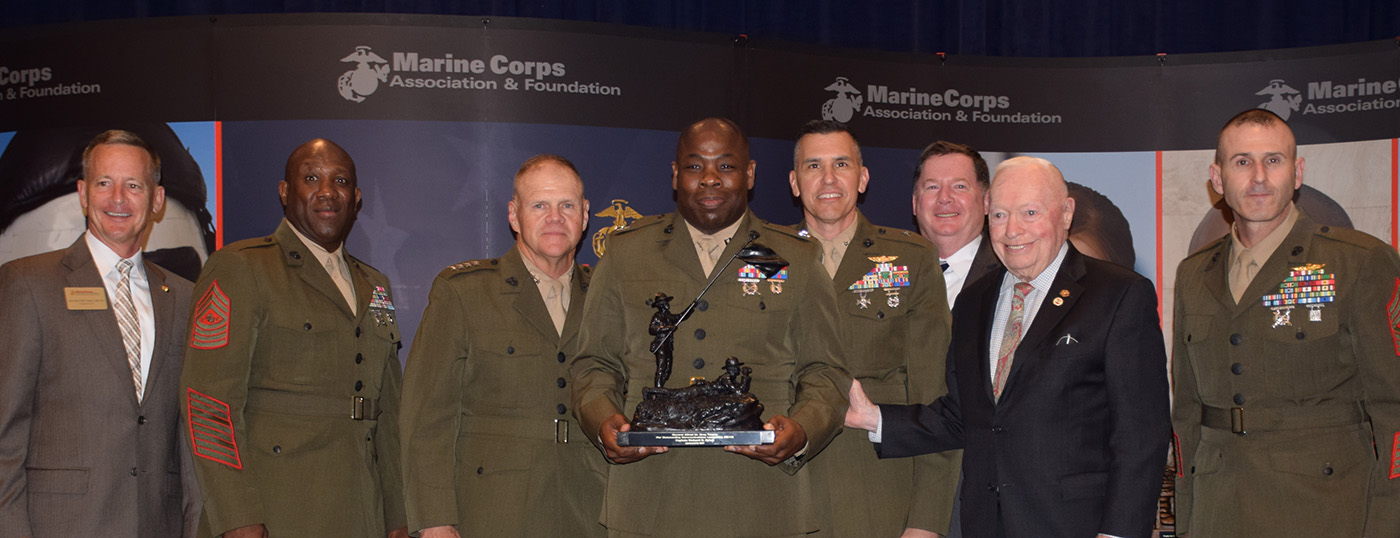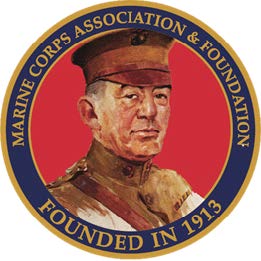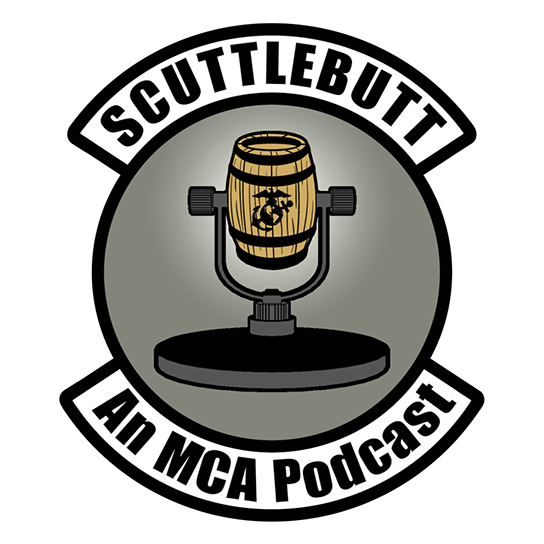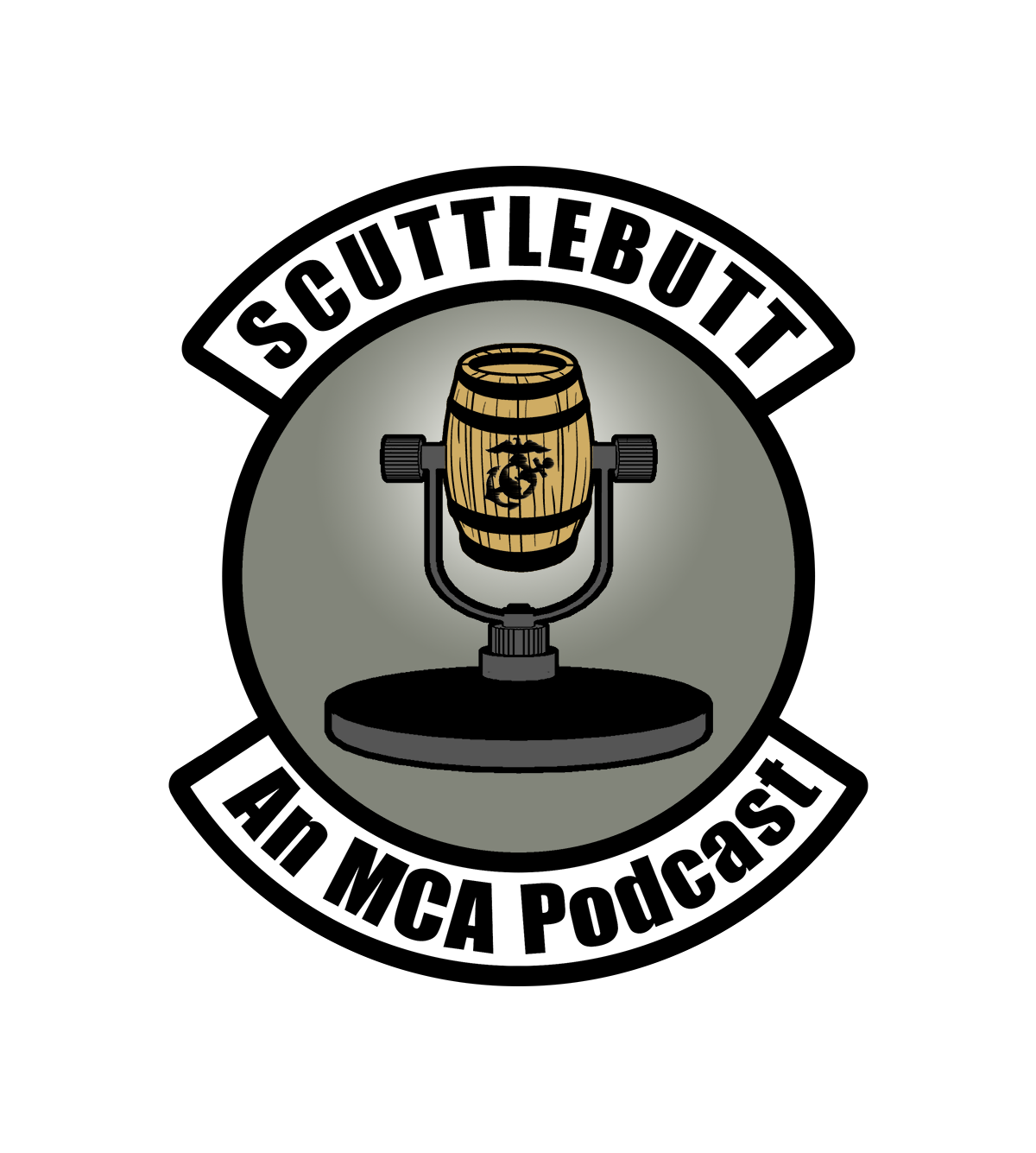Scuttlebutt Ep 31: Dr. Marc DeVore’s insights on Russia
Dr. Marc DeVore, a Senior Lecturer at the University of St. Andrews in Scotland, is an expert on the political economy of defense, the international arms trade, military innovation, and more joined Vic and William to help us understand Russia’s military and how we were so far off the target when it came to the outcome of their invasion of Ukraine. He shed insight on the nature of an Authoritarian Military, Russia’s desire to make their military look like it has America’s technological sophistication, and the risks for Ukraine in the event of a major counter-offensive.
After listening in, for more insight read Six Things NATO Can Do to Help Ukraine, which Dr. Devore contributed to.
The views and opinions expressed on Scuttlebutt are those of the individuals and do not reflect the official position of the Marine Corps Association.
Produced by Nick Wilson, Vic Ruble, William Treuting, and Nancy Lichtman.
Podcast: Play in new window | Download
Subscribe: Apple Podcasts | Spotify | RSS | More
Podcast (mca-scuttlebutt): Play in new window | Download
Subscribe: Apple Podcasts | Spotify | Amazon Music | RSS
Scuttlebutt Writer’s Guide
In this edition of Scuttlebutt Col Woodbridge joins Vic and William to discuss military writing for professional defense journals such as Marine Corps Gazette. Learn the broad strokes from argumentative, fact-supported positioning, to knowing the publication’s audience, to avoiding plagiarism. If you or someone you know is contemplating writing for a military journal, listen in and we look forward to reading your work!
The views and opinions expressed on Scuttlebutt are those of the individuals and do not reflect the official position of the Marine Corps Association.
Produced by Nick Wilson, Vic Ruble, William Treuting, and Nancy Lichtman.
Podcast: Play in new window | Download
Subscribe: Apple Podcasts | Spotify | RSS | More
Podcast (mca-scuttlebutt): Play in new window | Download
Subscribe: Apple Podcasts | Spotify | Amazon Music | RSS
This is My Rifle: M1 Garand
To read this article in PDF form Download Here
By Sam Lichtman
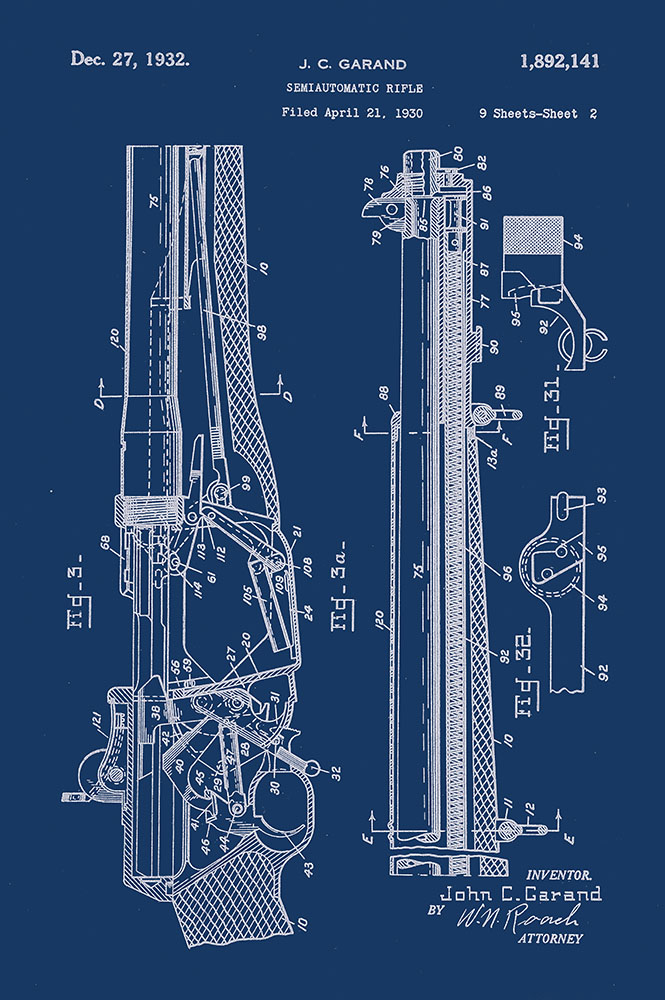
Perhaps more than any other military rifle, John Garand’s iconic M1 holds a special place in the hearts of military riflemen and civilian enthusiasts alike. From the jungles of the South Pacific to the infamous “Frozen Chosin,” Marines carried this revolutionary arm for nearly two decades, using it to deadly effect in some of the Corps’ most famous battles.
The year was 1932, and then-Major (later Major General) Julian S. Hatcher at the U.S. Army Ordnance Office had a problem. The Army had already decided that it wanted to replace the venerable bolt-action M1903 Springfield with a self-loading rifle to provide its riflemen with rapid-fire capability. Although there were no shortage of talented designers looking to sign a contract, Hatcher had no way to tell who was serious about building a suitable rifle and who was just a hobbyist looking for an easy cash grant. Furthermore, the workable designs that already existed had significant problems—after all, self-loading infantry rifles had been produced in small numbers since before the First World War, but no design had been good enough for a major military to adopt it as standard. A round of trials in 1924 had failed to find a rifle that was entirely suitable, but those trials set the stage for what was soon to come.
Self-loading, or semi-automatic, rifles had been modestly popular among hunters and sport shooters for decades. The ability to fire multiple shots in rapid succession without having to manually cycle the action was highly valuable in the field, but the designs weren’t nearly adequate for military use. Engineers had tried to scale up civilian designs like the Remington Model 8 and Winchester Model 1907 rifles, but they encountered serious problems: the rifles were usually some combination of heavy, inaccurate, fragile, unreliable, or expensive to produce. It quickly became clear that the standard .30 M1906 cartridge was much too powerful and the military’s requirements too stringent for an existing design to simply be adapted for soldiers and Marines to use in combat.
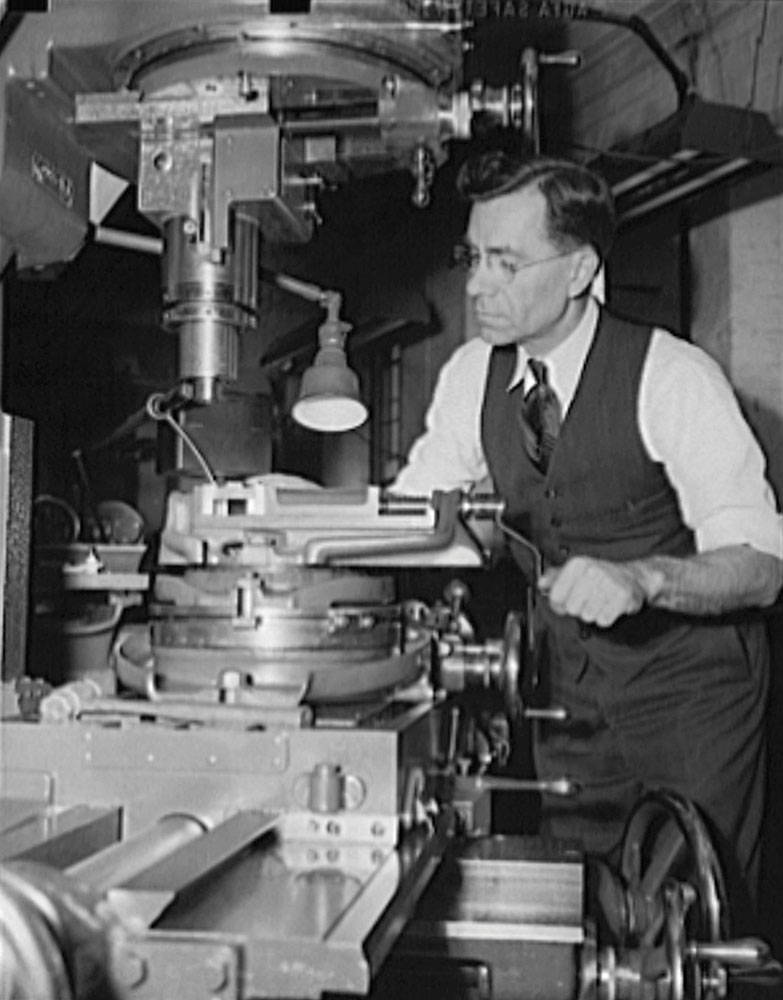
Enter two men named John—John Pedersen and John Garand. Pedersen was a seasoned, experienced firearm designer who had developed several commercially successful firearms while working for Remington. During WW I, Pedersen designed a conversion device which allowed the M1903 Springfield to be quickly adapted into a semi-automatic pistol-caliber carbine; it was adopted by the U.S. military and saw limited use by war’s end. John Moses Browning once called John Pedersen “the greatest gun designer in the world;” high praise from anyone, let alone Browning. Throughout the 1920s, Pedersen had been working on prototype designs for a reliable, accurate self-loading infantry rifle. When the Army started looking for one, he saw this as the perfect opportunity to have his design adopted.
Compared to heavyweights like Pedersen, John C. Garand was a relative unknown in the firearms world. Hailing from Canada, he was a mechanical engineer by training and trade. Much of his career had been spent designing industrial machinery for factories, a skillset which would later come to serve him well. Garand’s experimentation in arms design began in the early 1920s, culminating in his submission of a self-loading rifle to the unsuccessful 1924 Army trials. Changes to the way military ammunition was manufactured rendered the basic operating mechanism unworkable, but by the early 1930s, John Garand had again produced a design worthy of proper military trials.
In 1932, the Army ran another trials program to select and adopt a self-loading infantry rifle to replace the Springfield. This time, the playing field was dominated by only two serious contenders: John Pedersen with his T1E3 rifle and John Garand with his new and improved T3E2, both in caliber .276. Pedersen’s design used a toggle-delayed blowback mechanism with the breech locked by a sort of knee joint during firing. Garand’s design used a more conventional rotating bolt driven by a gas piston, which tapped expanding powder gases from the muzzle to operate the action. In the trials, John Garand’s rifle was found to be more robust and reliable than Pedersen’s and had one crucial advantage—it didn’t need lubricated ammunition. By virtue of its delayed-blowback operating mechanism, John Pedersen’s rifle would seize up and stop functioning unless the cartridges were lubricated, but its internal lubrication system increased complexity and allowed dust and grit to accumulate in the receiver, eventually causing malfunctions without careful cleaning.
The Army also had been testing the prototype rifles not in the standard chambering of .30-’06, but in an experimental .276. Military analysts had already determined that the new cartridge had a number of advantages suiting it well for use in a self-loading infantry rifle. Somewhat smaller and less powerful, the cartridge placed less strain on a rifle’s operating components and produced significantly less felt recoil, allowing soldiers and Marines to fire more rapidly and accurately. Furthermore, the lighter weight and lower production cost of each round allowed men to carry more ammunition into the field and stay in the fight longer.
During the late stages of testing, General Douglas MacArthur personally intervened to throw a proverbial wrench in the whole program. Wary of the additional complications a new infantry cartridge would pose for the U.S. military’s logistical network, MacArthur ordered that the .276 be abandoned immediately and all rifle development focus on the standard .30-’06. John Pedersen had designed his rifles around the .276 cartridge, but Garand had an ace up his sleeve—he had been working with the .30-’06 for longer. One of his crucial advantages was that he could readily redesign his T3E2 in .30-caliber, whereas Pedersen could not as easily scale his own designs up to fire the more powerful round.
This Garand prototype, designated T3E2, competed in U.S. Army trials beginning in 1932. It features a primitive “gas trap” system which taps expanding gases from the muzzle rather than the simpler and more efficient gas port arrangement found in most production M1 rifles.
Although Pedersen was known across the developed world for his design expertise, Garand’s rifle proved more effective and easier to manufacture. It was officially adopted as “U.S. Rifle, Caliber .30, M1” by the Army on Jan. 9, 1936.
The Marine Corps has traditionally been a little more conservative than the Army with adopting new rifles. Marine Corps brass in the late 1930s saw the rapid-fire capability of the Army’s new rifle as nothing more than a great way to waste ammunition and impede precision marksmanship. Despite their initial skepticism, the Corps ran a trials program of its own in 1940 to determine whether a semi-automatic rifle could be better than the venerable Springfield. They tested Pedersen’s and Garand’s designs along with a recoil-operated rifle designed by Marine reserve officer Melvin M. Johnson.
The Corps eventually decided to send some Johnson and Garand rifles to the Pacific theater to see how viable they were in combat. Both rifles, especially the Garand, quickly proved their worth against the Japanese in battles like Guadalcanal. The Japanese had long used the banzai charge as a way to dislodge enemy forces, and this tactic worked very well against Chinese conscripts armed with slow-firing Mausers. But against highly trained U.S. Marines with semi-automatic M1 rifles, a bayonet charge never stood a chance. Far from wasting ammunition, the sheer volume of fire provided by the new rifle allowed Marines to suppress enemy defenders and make rapid follow-up shots at moving targets.
Hearing positive feedback from Marines who had used the M1 in combat, the Marine Corps formally adopted the rifle to completely replace the M1903 and began mass issuing the new rifle to Marines in the field in early 1942.
Recall that John Garand was a production engineer with a great deal of experience designing factory equipment. This background allowed him to design the rifle for ease of production as well as the machines that would perform each operation. This proved to be a key factor in giving the United States an edge during World War II. They could manufacture and field in the mass quantities needed, something that tripped up the likes of the Soviet Union and Nazi Germany with their own self-loading rifle programs.
With America’s industrial might at their backs, riflemen of the United States Marine Corps used the M1’s fire superiority to fight their way all the way across the Pacific. Marines carrying M1s raised the American flag over numerous islands, and when war broke out on the Korean peninsula in 1950, soldiers and Marines picked their M1 rifles back up and went to go fight.
Warfare in the bitter Korean winter is very different from fighting on the hot, humid islands of the South Pacific, but John Garand had designed his rifle to function in extreme cold as well as heat. During the Battle of the Chosin Reservoir in 1950, Marines found that their M1s still functioned perfectly fine, except for one thing—lubrication. All firearms require proper lubrication in order to function reliably, and the M1 is no exception, but the natural oil in service at the time had an unfortunate tendency to thicken and gum up in the extreme cold temperatures. Undeterred, Marines simply stripped all the lubricant out of their M1s and ran them bone-dry—and the rifles kept on working.
Even after serving in two wars, the M1 kept soldiering on. Years of work on modifying and improving the rifle’s base design culminated in the adoption of the M14 in 1957. Despite the external differences, every M14 and variant thereof can trace its lineage directly back to the M1. Despite its official replacement, the M1 itself endured in frontline service. It dutifully guarded the inner German border and other hotspots around the world until 1961 when the last examples were finally phased out and sent back to Springfield for refurbishment and storage.
During the 1950s and beyond, militaries on six of the seven continents fielded M1 rifles received from the United States as military aid. Even after they were taken out of American service, M1 rifles gained a new life among civilian marksmen—many of them soldiers and Marines who had carried them in combat. Through the Office of the Director of Civilian Marksmanship (DCM), managed by the War Department, members of shooting clubs across the country could purchase refurbished military surplus rifles that were no longer needed by the U.S. military. To this very day, the DCM—now known as the Civilian Marksmanship Program—sells original 1940s and 1950s production M1 rifles for match shooting.
Few historic military arms have garnered such enduring popularity as the M1. This rifle, revolutionary for its time, is still held in high regard; its influence on tactical doctrine, marksmanship, and later firearm designs is felt in the modern day. Marines at Tarawa, Saipan, Iwo Jima, Inchon, Outpost Vegas and hundreds of other battlefields didn’t know how famous the rifle would become, of course. All they cared about was whether it worked, and as the record reflects, it did indeed.
Editor’s note: Special thanks to Jonathan Bernstein at the National Museum of the Marine Corps and Geoffrey Roecker of MissingMarines.com for technical research and assistance with photos.
Author’s bio: Sam Lichtman is a college student and licensed pilot. He works part-time as a manager at a gun store and occasionally contributes content to Leatherneck. He also has a weekly segment on Gun Owners Radio.
Scuttlebutt 29: Ukraine Week 6
Everyone here at Scuttlebutt is blown away by the resolve and the fighting spirit of the Ukrainian people as they face down Russian missiles, tanks, and soon, maybe even conscripted soldiers. Nick, Vic, and Will explore the war in Ukraine and some of the directions it has taken and touch on the global interconnectivity of the conflict.
Also, Nick and Vic celebrated their birthdays on back to back days last week.
The views and opinions expressed on Scuttlebutt are those of the individuals and do not reflect the official position of the Marine Corps Association.
Produced by Nick Wilson, Vic Ruble, William Treuting, and Nancy Lichtman.
Podcast: Play in new window | Download
Subscribe: Apple Podcasts | Spotify | RSS | More
Podcast (mca-scuttlebutt): Play in new window | Download
Subscribe: Apple Podcasts | Spotify | Amazon Music | RSS
Scuttlebutt 28: Col Milburn’s Journey
Irony: We pushed back our episode with Col Milburn to cover Ukraine. Now, he is in Ukraine.
We sat down with Col Andrew Milburn, USMC (Ret), author of When the Tempest Gathers, writer of articles across the internet, and one of the most interesting humans on the planet. Before he was a Marine, Andrew Milburn was a young man journeying on foot across Asia in the 80s, right through Iran, post-revolution. Hear the full story as well as some prescient insight on the modern Corps in this week’s episode!
The views and opinions expressed on Scuttlebutt are those of the individuals and do not reflect the official position of the Marine Corps Association.
Produced by Nick Wilson, Vic Ruble, William Treuting, and Nancy Lichtman.
Podcast: Play in new window | Download
Subscribe: Apple Podcasts | Spotify | RSS | More
Podcast (mca-scuttlebutt): Play in new window | Download
Subscribe: Apple Podcasts | Spotify | Amazon Music | RSS
Scuttlebutt 27: Marines in the Brig with CW04 Denise Barnes, USMC (Ret)
Recently retired Chief Warrant Officer 4 Denise Barnes joined Nick, Vic, and William in studio to educate us on an MOS we know so little about: Corrections. The trailblazing Barnes, along with one other, was one of the first women to achieve CW04 within the MOS, and we were lucky to have her because she has seen it all, from the high profile PFC Manning to Iraq to the day-to-day of the brig. We also got to learn a little bit about Trinidad, where Barnes was born and raised, and how growing up in a friendly, tight-knit community made joining the Marines a natural fit.
The views and opinions expressed on Scuttlebutt are those of the individuals and do not reflect the official position of the Marine Corps Association.
Produced by Nick Wilson, Vic Ruble, William Treuting, and Nancy Lichtman.
Podcast: Play in new window | Download
Subscribe: Apple Podcasts | Spotify | RSS | More
Podcast (mca-scuttlebutt): Play in new window | Download
Subscribe: Apple Podcasts | Spotify | Amazon Music | RSS
Scuttlebutt 26: Talking Taiwan with Dr. Hunzeker
In what was originally recorded as an Amphibiosity interview shortly before the Russian invasion of Ukraine, our talk about Taiwan’s defensive posture takes on a whole new meaning. In light of Ukraine’s valiant defense, inflicting heavy losses on a numerically superior enemy, we look to the Far East to see if we can’t apply any lessons from Ukraine to the Straits of Taiwan.
Nick, Vic, and William talk about the ongoing conflict in Ukraine before transitioning to our conversation with Dr. Hunzeker to cover the Defense of Taiwan from Paladins, tanks, and amphibious landings to cultural misgivings, geography, and the political climate.
The views and opinions expressed on Scuttlebutt are those of the individuals and do not reflect the official position of the Marine Corps Association.
Produced by Nick Wilson, Vic Ruble, William Treuting, and Nancy Lichtman.
Podcast: Play in new window | Download
Subscribe: Apple Podcasts | Spotify | RSS | More
Podcast (mca-scuttlebutt): Play in new window | Download
Subscribe: Apple Podcasts | Spotify | Amazon Music | RSS
The enduring legacy of Warfighting provides impact three decades later
A Message from The Commandant of the Marine Corps
Thirty-three years ago, the 29th Commandant of the Marine Corps, General Al Gray, published Fleet Marine Force Manual 1 – Warfighting. This “little white book” was, and is, one of the most important statements our Service has ever made about how we understand the essential foundations of our profession: what war is, how we prepare for it, and how we fight when it comes. This anniversary is an appropriate time for us to pause and consider the impact of Warfighting, what it means for us today, and where we need to go with its ideas in the future.
As the largest and most flagrant act of conventional armed aggression in Europe since 1945 unfolds in Ukraine, many of us are naturally reflecting on what we think we know about warfare, and what has and has not changed over the years. The Marines who wrote Warfighting, and the strategists and thinkers of different eras upon whose ideas they drew for inspiration, were engaged in a similar sort of active reflection, fusing their observations about contemporary affairs with their knowledge of history to advance the profession. As General Gray later observed, this process was, and remains, essential: “Like war itself, our approach to warfighting must evolve. If we cease to refine, expand, and improve our profession, we risk becoming outdated, stagnant, and defeated.”
With this admonition in mind, it is worth remembering the breadth and excitement surrounding the bottom-up revolution in military thought that produced FMFM 1. This was not limited to the Marine Corps, but was really the last genuine far-reaching period of reform for the U.S. military as a whole. It was a true civil-military effort to process defeat in Vietnam, the ever-present Soviet threat, advances in military technology, and ongoing learning from the operational successes and failures of both American and foreign militaries into the doctrine and organizational structures that still shape our activities today. Politicians and their advisors, generals, historians, and more junior military members in all the services put their utmost energies into this learning process. It produced not only the maneuver warfare concepts that have shaped the thought of Marines for decades, but also the efforts at Joint integration reflected in the Goldwater-Nichols legislation and the far-reaching revolution in professional military education and manpower management that flowed from it.
For Marines, this remarkable achievement enshrined in our basic doctrine an understanding of the nature of war that is timeless. Warfighting reminds us of essential factors in war that we ignore at our peril: the power of the human will and spirit; the ever-present influence of friction, fog, and chaos; and the likely futility of any approach to warfare that seeks an unattainable certainty or prioritizes a single element of the combined arms equation over the integrated application of the whole.
Warfighting, like the works of other great strategic minds that inspired it, is above all else a theory grounded in history – and we must ensure that our understanding of that history remains sound. While advances in technology generate a great deal of discussion and are obvious to all, less obvious is the fact that our understanding of history itself has also evolved. Are we assessing both the march of technology and the lessons of history as regularly and aggressively as we should? Are we adjusting our course as necessary? Are we being true to the 29th Commandant’s challenge to “refine, expand, and improve our profession” and evolve our approach to warfighting?
I believe we are, but we must commit to a more rapid pace of institutional learning to meet the challenges of both today and tomorrow. A quick look at the headlines on any given day makes obvious the urgency of the effort. In the spirit of the era of deep thinking and great reform that produced FMFM I, I want to hear more from Marines at all levels, and those who support and care about Marines, on the lessons of contemporary and more distant history, and about the implications of the current era of unprecedented technological change on warfighting. As Marines, “becoming outdated, stagnant, and defeated” is simply not an option.
Semper Fidelis
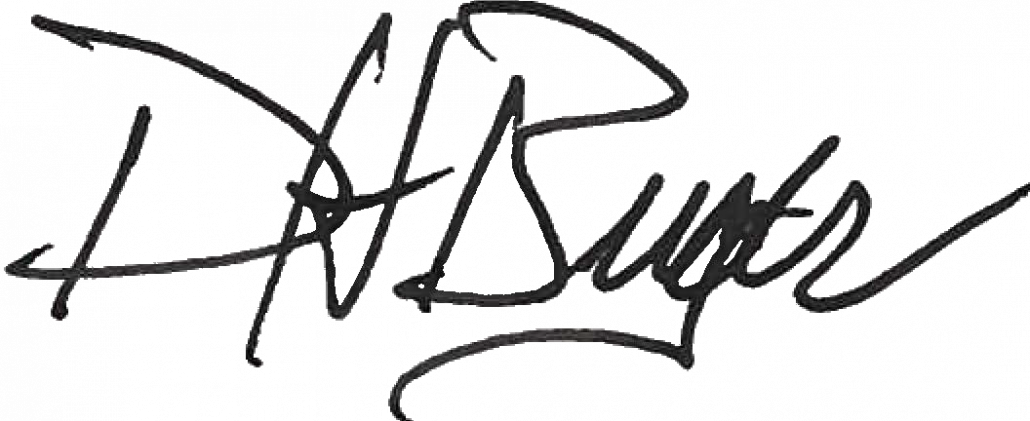
David H. Berger
General, U.S. Marine Corps
Commandant of the Marine Corps

Scuttlebutt 25: Ukraine Invasion Week 2
Nick, Vic, and Will are joined by Col Woodbridge, USMC (Ret), Editor of Marine Corps Gazette and using Clausewitz’ cause for war analyze why the Russians and Ukrainians are each fighting, how it impacts NATO and the EU, and talk about whether or not the US can support a Ukrainian insurgency, should the Russians win with late-20th, early-21st century siege tactics.
The views and opinions expressed on Scuttlebutt are those of the individuals and do not reflect the official position of the Marine Corps Association.
Produced by Nick Wilson, Vic Ruble, William Treuting, and Nancy Lichtman.
Podcast: Play in new window | Download
Subscribe: Apple Podcasts | Spotify | RSS | More
Podcast (mca-scuttlebutt): Play in new window | Download
Subscribe: Apple Podcasts | Spotify | Amazon Music | RSS
2018 Fall Newsletter

Marines and Friends of Marines,
I am pleased to share this Marine Corps Association Foundation Newsletter with you. Established in 2009 to fill a void in programs that could not be supported by Marine Corps appropriated funds, the Marine Corps Association Foundation continues to make a difference in the professional development of today’s Marines. In 2017, our programs supported more than 50% of all active duty Marines as Marines across the globe benefited from our Commanders’ Forums, Commanders’ Unit Libraries, Marine Excellence Awards and Marine Writing Awards Programs. None of this support would have been possible without your generosity and loyal commitment to Marines and our nation’s security.
With most of this year already behind us, we are well on our way to another successful year in 2018. Although we are on track, we cannot remain there without your continued support. We realize there are many worthwhile choices for your precious charity dollars, but I encourage you to continue supporting the Marine Corps Association Foundation —today’s Marines are benefiting from your donations.
Your faithfulness and commitment to our mission is awe-inspiring, and I want to thank you for the support you have provided to date. Just like the Marine Corps, however, its professional association cannot afford to rest on our laurels. I hope we can continue to count on you.
Semper Fidelis,

William M. Faulkner
Lieutenant General, United States Marine Corps (Ret)
President & Chief Executive Officer
Marine Corps Association & Foundation
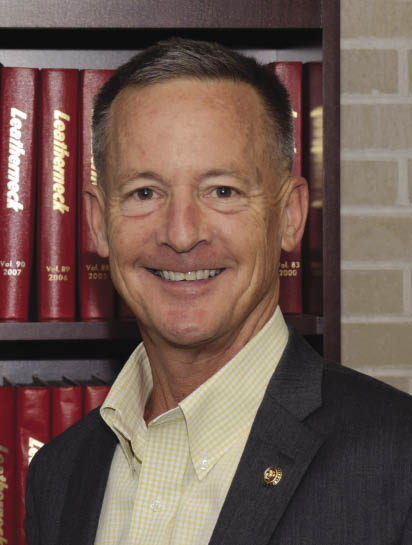
2018 has been a tremendous year thus far for the Marine Corps Association Foundation thanks to the contributions of donors and members like you who are helping us make a difference in the professional and leadership development of today’s Marines. Last year our programs impacted nearly 90,000 Marines and demand continues to grow this year.
As the Director of our Foundation, it’s my privilege along with the members of my team to hear the comments, and read the emails and letters we receive from the Marines as well as their commanders and senior enlisted leaders. We see how our programs enhance their careers. Now it’s your turn. Over the next several pages, you’re going to read about the professional education and development of Marines throughout the Corps and see how we capitalized on historical events like the 100th anniversary of the Battle of Belleau Wood to use our programs in new and creative ways. These inspiring stories and quotes show how much our programs mean to Marines — programs only possible because of faithful supporters like you! Once you finish this newsletter, I hope you will commit to continuing or increasing your contributions to the Marine Corps Association Foundation. You are the reason we can accomplish our mission!
Semper Fidelis

Timothy S. Mundy
Colonel, USMC (Ret)
Director, Marine Corps Association Foundation

Foundation Staff
Kevin Bennet
Sergeant Major, USMC (Ret)
Beth Murphy
Danielle Graham
Shelby Conley
MCAF’s Programs

Commanders’ Forums, including battlefield studies, guest speakers, and other venues that help Marines develop their professional tactical, operational, and strategic acumen and provide opportunities for Marines to learn firsthand the lessons of history and their application to the issues of today. This program provides the most latitude and creativity to commanders and their senior enlisted leaders and provides the most impact to their Marines.
The Marine Writing Program encourages open dialogue and critical discussion on topics important to Marines and the Marine Corps today through a variety of essay contests for all ranks. The program continues to evolve and this year, with the recent passing of LtGen Bernard “Mick” Trainor, a new writing award was established in his name. A “Marine’s Marine” with a remarkable career that spanned both military and journalistic endeavors, he was known as an exemplary leader and a man of strong moral character, and this award will inspire others to follow in his footsteps.
Another of our writing awards is specifically linked to Leatherneck — Magazine of the Marines, and supported by one of our donors. While our other awards are open to Marines of all ranks, the Leatherneck Writing Award is restricted to enlisted Marines in the hopes of encouraging our younger leathernecks to write for our publications. Twenty-seven entries were received for this year’s competition, and for the third year in a row, the winning essay was written by a lance corporal. Lance Corporal Kyle Daly wrote an outstanding essay on the legacy of LtGen Holland M. “Howlin’ Mad” Smith, which will be published in the October issue of Leatherneck. It is inspiring to see what our young Marines can accomplish when given the opportunity, and those opportunities are provided by your generous donations.
The Unit Library Program provides books from the Commandant’s Professional Reading List to enable Marines to read and study military classics, current topical books, and other works of historical significance. The study of the profession of arms is critically important to Marines of all ranks, and each year we send additional copies to unit libraries around the Corps to ensure even more books are available to Marines. Our goal is to expand this program into downloadable audio books, but this is only possible with your support.
A great example of the impact of our Unit Library Program is in the Officer Candidates School quarterly professional military education and communications program. The Commanding Officer of OCS, Col Ahmed “Will” Williamson, and his sergeant major, Sergeant Major Lance Harrell, asked their junior officers and staff noncommissioned officers for input on recommended books and topics for discussion. Their recommendations were built into an annual plan in which the Marines of the OCS staff read and discuss selected books in monthly small groups, write essays and have quarterly discussions, culminating in a unit professional dinner. MCAF has provided significant support to their efforts by furnishing the books for this leadership development program, publishing some of the essays in Leatherneck or the Marine Corps Gazette, and sponsoring a guest speaker or author at these dinners. Your support makes this possible.
Marine Excellence Awards recognize the achievements of Marines throughout the Corps, whether they are Recruit Honor Graduates, outstanding Marines in specific military occupational specialties or Marines of the Year from each Marine division, among many others. Many of our annual awards are presented at Marine Corps Association & Foundation Professional Dinners, often by the Commandant of the Marine Corps, the Sergeant Major of the Marine Corps or other senior Marine Corps leaders. These awards are tangible examples of just how amazing the young men and women are in our Corps and are only possible because of your generosity.
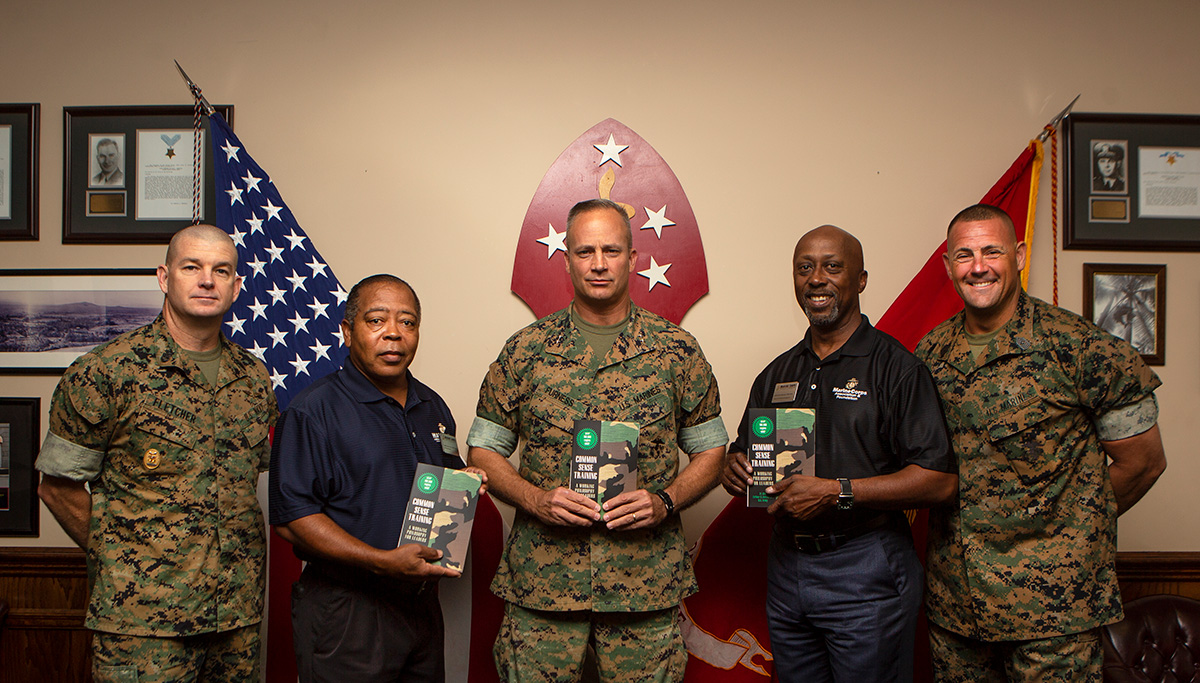
Belleau Wood
2018 marked the 100th anniversary of Belleau Wood, one of the “touchstone battles” of our Corps, according to our 31st Commandant, General Charles C. Krulak. The Marine Corps Association Foundation had the privilege of helping several groups of Marines attend the anniversary ceremony in May, and the difference it made in their development as leaders is already evident.
Headquarters & Service Battalion, Marine Corps Base Quantico, Virginia, envisioned a contest in which teams comprised of a company grade officer, staff noncommissioned officer, noncommissioned officer, and junior Marines or sailors would write a 1500 word essay, design a tactical decision game, and give a formal presentation to a panel of judges. Teams used a variety of innovative means with their presentations including having a Marine in today’s combat uniform and gear travel back in time to have a discussion with a Marine in a WWI period uniform, with each comparing tactics, gear, and weapons. The confidence all the teams showed with junior Marines having to be part of each presentation given to a panel that included the Commanding General, Education Command, several colonels, and a civilian faculty member of the Marine Corps University staff, was truly inspiring. Teams were effusive in their praise of the contest and especially enjoyed working with their fellow Marines and learning more about the iconic battle.
The Belleau Wood contest was a perfect blending of all elements of the Foundation’s programs: reading, writing, tactical thinking, and a professional battle study, all of which culminated in a trip to Paris and Belleau Wood! The winning team from Headquarters Marine Corps’ Separations and Retirement Branch attended the 100th anniversary ceremony in France and then spent two days walking the ground of the battle they had studied.
As amazing as the competition was, the impact it had on the Marines who participated was remarkable, as you’ll read in their own words below. The programs you support truly do lead to professional development for today’s Marines.
“This experience has changed me. It caused me to become a critical thinker and made me realize that ignorance is not an excuse, we all need to learn. I highly recommend the opportunity to conduct a staff ride. Knowing what happened is one thing, being there is another thing. Visiting the very place that our predecessors fought really lets you see the reality of it. It was surreal, very moving.”- LCpl Denisha Milligan, MMSR-4
Of note, based on her increased maturity and professionalism resulting from her participation in this contest and trip to Belleau Wood, LCpl Milligan was selected as her unit’s Marine of the Quarter, and will serve as the noncommissioned officer in charge of her section upon her upcoming promotion to corporal.
“It is important that we learn about such keynote battles [and] our history, because such battles are what established our foundation and warfighting spirit.”- LCpl Shenoah White, MMSR-4.
Senior Marines have noticed a new confidence in the participants and say they are better Marines and leaders. In the words of the team OIC, “This competition served as the catalyst to enable them to come out of their shell and become leaders. Each Marine is setting a shining example on how such a competition can professionally and personally develop our Marines.” This is the true impact of Marine Corps Association Foundation programs which, thanks to donors like you, make a tangible difference in the lives of Marines.
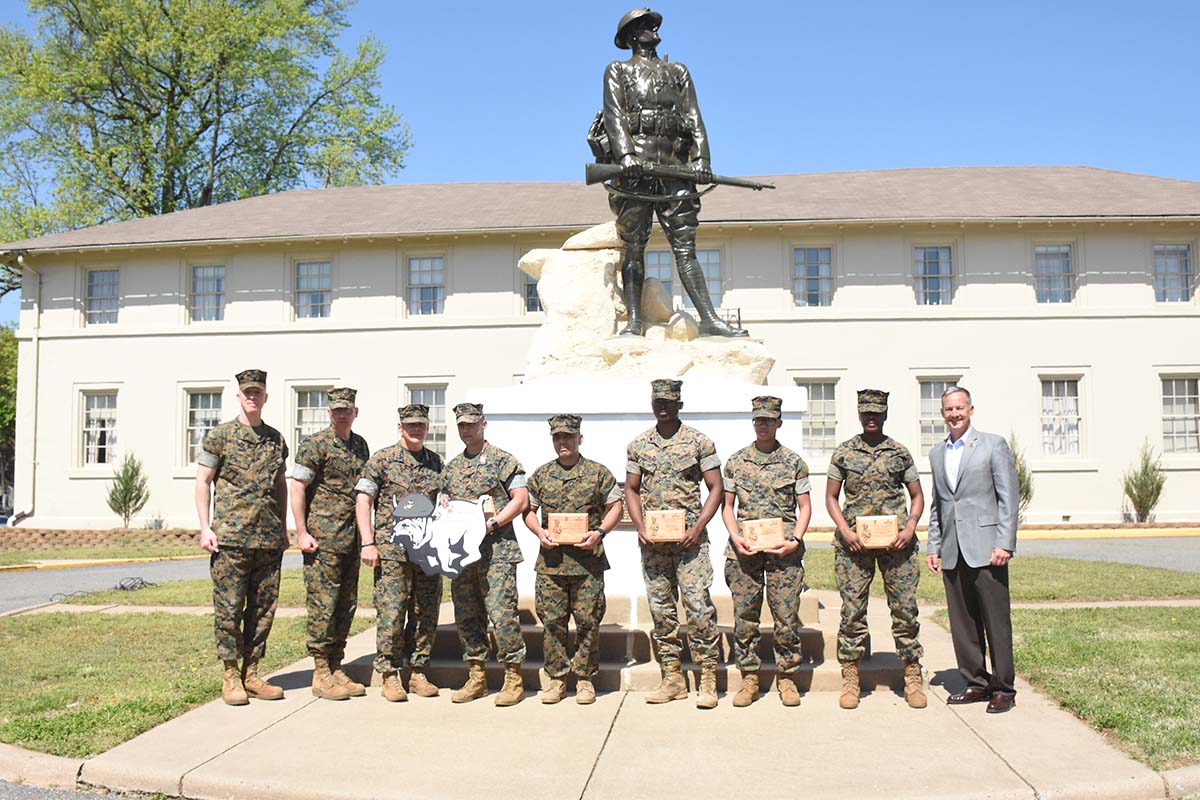
“Once again, on behalf of the team, thank you and the Marine Corps Association Foundation for this opportunity. Not only were we able to dissect a battle that has really defined the Corps, but it was inspiring to see the development of the junior Marines. This project has caused me to reevaluate my training plans and I will incorporate many lessons learned from it. Also, thank you for the opportunity to walk the hallowed grounds of Belleau Wood. It was a once-in-a-lifetime opportunity that will forever leave an impression on the Marines and myself.”- Captain Brian Perez
Support to the Marine Corps University
The Marine Corps Association Foundation also supported a Marine Corps University-sponsored writing competition in conjunction with the Belleau Wood anniversary with essays written by four different groups: junior Marines, noncommissioned officers, staff noncommissioned officers, and officers. The competition was open to Marines across the Corps with 1st, 2nd, and 3rd place winners selected from each group. The monetary awards presented were made possible thanks to your contributions. The overall winner, selected from the top finishers in each group, was also sent to France for the 100th Anniversary ceremony and battlefield tour. The winning essays from each group were published in the Marine Corps Gazette, and the authors were brought to Quantico for a Marine Corps University lecture series where they received their plaques and cash awards. The keynote speaker at the lecture series was General Charles C. Krulak, USMC (Retired), who obviously understands the impact of Belleau Wood on today’s Corps. Your support of the Marine Corps Association Foundation enabled this remarkable experience for these Marines.
The Basic School
And finally, as part of the Belleau Wood anniversary, the Commanding Officer of The Basic School requested support so a group of his staff consisting of officers and enlisted Marines could also participate in the commemoration. Aiding the development of these leaders, who will mentor and instruct our newest officers, was a great opportunity only possible because of your dedication and contribution to the Foundation.
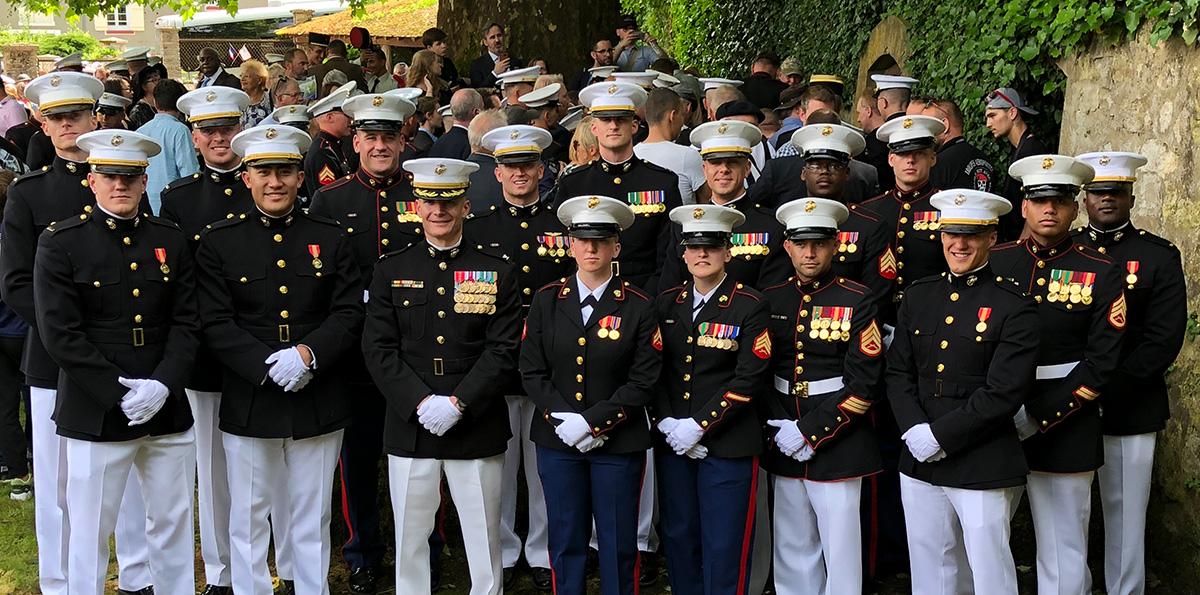
Victor E. Johnson Uniform Award
A unique component of our Excellence Awards program, initiated through the generosity of Christopher Bird and his family, is the Victor E. Johnson Uniform Award. This award is presented at every Officer Candidates School graduation to the prior enlisted Marine with dependents who earned the highest overall leadership score. In order to offset the financial burden of purchasing new service and dress uniforms for these Marines and their families as they start their careers as officers, the VEJ Uniform Award provides a gift card for The Marine Shop, which covers the cost of the required uniforms. The award makes a significant difference for these Marines and they also benefit from the highest quality uniforms, expert tailoring, and unparalleled customer service of The Marine Shop. One of our previous award winners, Staff Sergeant Mark P. Grill, put it best:
“As I see it, the Victor E. Johnson Uniform Award is dedicated to creating opportunities and responsibilities. This award will undoubtedly allow my family and me to seize many opportunities we would have surely missed out on due to the cost of uniforms while serving as a commissioned officer in the Marine Corps … Most importantly though, this award will allow my family to begin the next chapter of our Marine Corps lives on sound financial footing and will allow me to lead and serve Marines with an amazing set of new professional uniforms. I will never be able to express my full gratitude for this amazing award and what it means to the Grill family and would like to take this opportunity to express my heartfelt gratitude to the Bird family, the Marine Corps Association Foundation and all the donors that make this incredible award possible.”
Levels of Giving
The Marine Corps Association Foundation recognizes our donors by giving societies. We are thankful for donors at any level, as even small amounts add up and make possible the tremendous programs highlighted in this newsletter. If you donate to the Foundation annually, at any cumulative amount reaching $100 or more, then you are a member of one of our giving societies, each with a name symbolic of our Corps. Thank you!
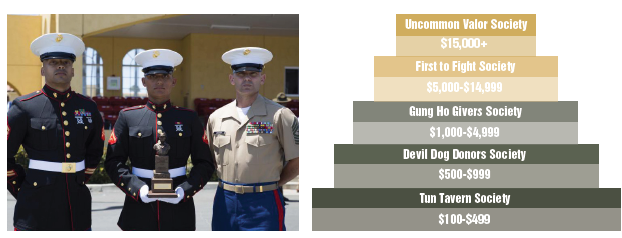
Donor Profile
Colonel Russell D. Doudt, USMCR (Ret)
Colonel Russell D. Doudt, USMCR (Ret) has been a donor to the Marine Corps Association Foundation since its inception in 2009. As a former commanding officer, he understands the need for professional development of all Marines and how the Foundation assists commanders in ensuring their Marines have the tools and resources needed to grow as leaders. “When I read about the Marine Corps Association Foundation, I saw substantial value in its programs to develop officers and enlisted Marines; I immediately bought into it. MCAF provides officers and enlisted Marines an opportunity to improve their professional military knowledge through reading, battlefield tours, and writing articles.”
A staunch believer in professional military education, Col Doudt also knows that individual Marines share responsibility in their personal and professional development. “I have found that if a person really wants to be proficient in their profession, they need to do more than just perform their daily assigned responsibilities. MCAF provides an opportunity to achieve this level of performance. Complementing this, MCAF rewards and recognizes those Marines who perform at an exceptional level through their Excellence Awards Program.”
Col Doudt continued extolling how MCAF assists today’s Marines. “It is the combination of providing opportunities for Marines to increase their military knowledge and then professionally recognizing those Marines who demonstrate exceptional performance, achievement, and accomplishments.” Supporting today’s Marines is especially personal for Col Doudt, whose daughter is on active duty. He has seen the benefits of our programs supporting professional military education up close. “My daughter is a captain currently stationed in Okinawa. She was recently stationed at Quantico and told me how interesting she found the battlefield tour of Gettysburg that she did during a Professional Military Education (PME) trip. I have personally toured the Gettysburg battlefield, so I understand what she is talking about. It is rewarding to me to have been able to help provide the financial support for Marines to visit significant battlefields during PMEs and observe firsthand, how terrain features influence command decisions.”
It’s because of people like Col Doudt and their generous donations that we ensure Marines throughout the Corps continue to visit battlefields, study their profession, and learn the lessons of our past — all of which make stronger individual Marines and a better Marine Corps.
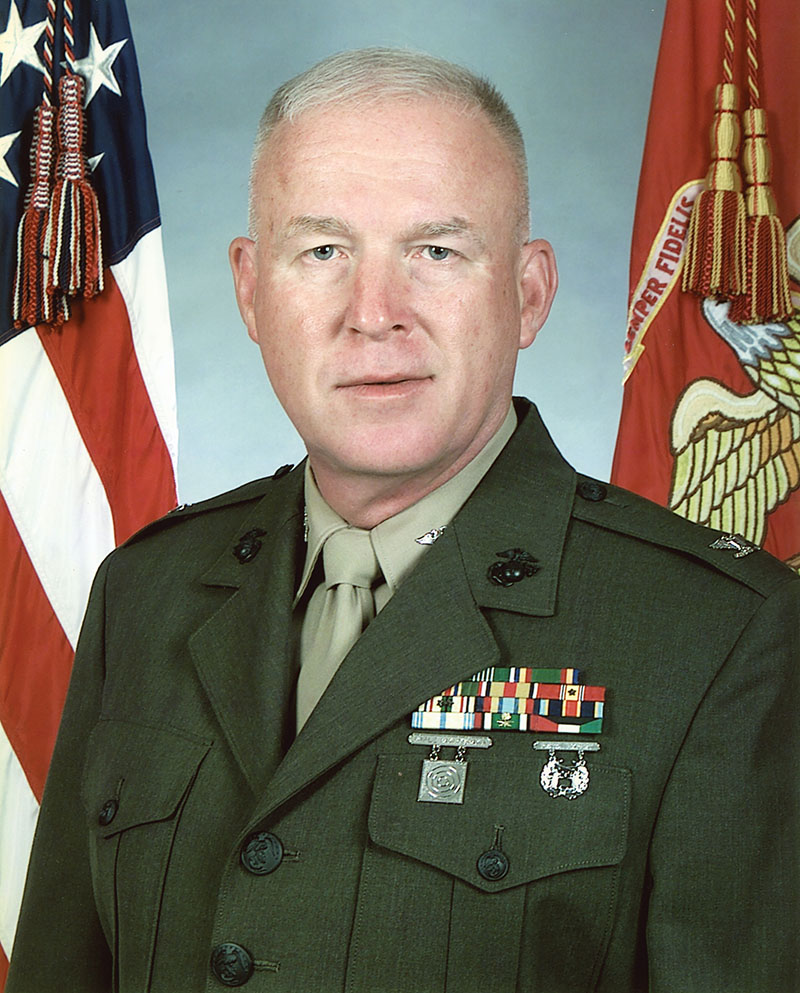
Planned Giving
When reviewing our estate plan, my wife, Marlene, and I wanted to ensure that, in addition to our children and grandchildren, we left a final donation to several causes that we felt were remarkable in the good that they were providing. Among those causes is the Marine Corps Association Foundation (MCAF), which does so much for so many Marines.
Most people are familiar with our publications, the Marine Corps Gazette and Leatherneck — Magazine of the Marines, but these are only part of MCAF’s extensive educational and professional development efforts, which include unit libraries and staff rides to name a few. Moreover, MCAF recognizes outstanding performance by providing thousands of awards annually to deserving Marines for schools, training, and MOS accomplishments. No other organization does these things to develop leaders and recognize excellence.
Our bequest to MCAF is our way of providing a final “Thank You” for all that MCAF does. I wholeheartedly urge others to remember MCAF in their wills and estate plans at whatever level you are comfortable. It doesn’t need to be a huge amount to make a real difference to today’s Marines.
Major General Eugene Payne, USMCR (Ret)
Chairman, Marine Corps Association Foundation
Board of Directors
Thank You
A special thank you to LtCol Ron Eckert, USMC (Ret.)
for his support of this newsletter. Ron, a longtime member of the Marine Corps Association and also a member of our Board of Directors, along with his business partner Mr. Henry Friedman and the company they founded, Impact Resources Technologies, has generously supported MCAF and its programs for today’s Marines for many years. A retired Marine officer, Ron served two tours in Vietnam and was a key contributor to the Marine Corps football program as both a player and as the team’s last coach. He generously donated the painting below to the National Museum of the Marine Corps in commemoration of the Marines who represented the Corps so well on the gridiron.
A final thank you to our individual donors and corporate sponsors whose generous contributions have been instrumental to the support the Marine Corps Association Foundation provides to Marines around the globe. Whether corporations with a strong sense of civic responsibility, veterans who continue to serve our nation in new ways, proud family members of Marines, or simply friends of the Corps, you have truly made a difference in the professional development of today’s Marines. You should be proud of what you are doing for them.
